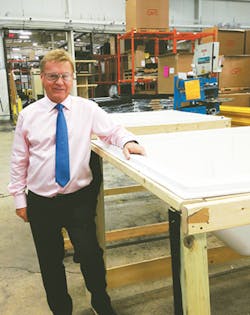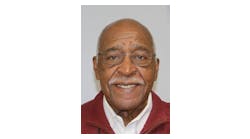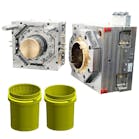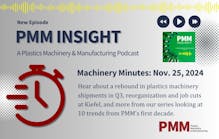Wis. thermoformer's latest projects include expansion, enhanced automation
At industrial thermoformer General Plastics Inc., Milwaukee, owner and President Bob Porsche invests in innovation every year. That is the rule by which he has operated this business for three decades. These investments can come in the form of new machinery or a plantwide restructuring.
The latest projects are a 42,000-square-foot addition to the existing 51,000-square-foot facility, and a focus on enhancing automation and controls technology. The company is focused on creating optimal flow of the products traveling through its forming, trimming and shipping areas. General Plastics forms truck bed liners, other vehicle components, medical housings, construction-related products and many other large industrial products.
"We re-laid out the entire facility for a five-year plan," Porsche said. "And then we worked backwards and started with what we were going to do and accomplish this first year, which was re-laying out machinery for efficiencies and the flow. We added more storage. We moved out of a warehouse — we had a warehouse that we leased off-site about a half mile away."
The efficiencies and flow of the facility mean everything when it comes to serving a growing customer base, he said. The configuration is such that a product moves from the forming machines directly to the CNC machines or robots for trimming. "When we schedule, we want a clear path so that when we move it from Point A to Point B and then we do a lot of value-added and assembly, we need to be able to flow it to assembly and fit it in assembly," he said. "A lot of our manufacturing customers want us to give them turnkey products so they can just take the part and run it directly to their line and assemble it onto whatever it's going onto. That is the big goal: The more we can respond, the larger we can grow our business. It's really important that the response time be quick."
The company's plant now is equipped with 11 state-of-the-art thermoformers, including a rotary thermoformer from Modern Machinery of Beaverton Inc., based in Beaverton, Mich. Maac Machinery Corp., Carol Stream, Ill., has supplied the others, which include two three-station rotary thermoformers that are among the latest additions. These behemoths are about 30 feet in diameter at a height of 18 feet. The machines can form a part measuring 6 feet by 10 feet by 4 feet. One of the three-station rotary thermoformers is a pressure former; the other is a vacuum former.
"I like new equipment; I like new technology; I like new toys," Porsche said in an August interview at General Plastics. "To me, it's an expensive toy I want to use to make my living."
This approach also helps to boost the bottom line over time. It could also be one of the reasons General Plastics was named Wisconsin's Manufacturer of the Year in 2014 for companies that have fewer than 100 employees; a plaque marking the achievement hangs prominently on the wall in a conference room. General Plastics also was honored this fall by the Metropolitan Milwaukee Association of Commerce with its Future 50 award. This award recognizes companies for significant revenue and employment growth.
Out with the old
When General Plastics last replaced its old technology, Porsche did away with ceramic ovens that lacked tight heating zones. In their place came quartz ovens that had the zone sophistication he wanted.
For example, if the oven is 6 feet by 10 feet but the part that is running is only 2 feet by 2 feet, the oven with the better technology can target heat to the 2-foot-by-2-foot part.
"I don't want to heat any more than I have to," Porsche said. "We've reduced our energy — our electric bill — every year for the last three years, even with the additional equipment, because of the energy efficiency that we've gained. That is huge, in my mind. We're still at a point that energy is reasonable, but it's not going to be forever. You have to do things with foresight."
Through this approach, he reduces maintenance requirements; he also reduces the cost of labor and is focused on having the most state-of-the-art controls. Now, General Plastics can put 200-400 parts programs in its forming machines. The company performs much of the programming for CNCs and robots offline, then does the final tweaking at the thermoforming machine.
"The controls and ease of doing that are much greater," he said.
He also is reducing energy costs overall with the continual implementation of newer technology.
"I work with the energy companies to guide me in that direction and they also rebate us," he said. His used equipment goes on the market through Plastics Machinery Group International Ltd. (PMG), Solon, Ohio. "We're able to sell our equipment at good value because we maintain it very well; so that is the other portion of the equation. We have high-end maintenance on our older equipment and when Don [Kruschke, president of PMG] goes to sell it, he doesn't have any trouble. He's actually coming after me to sell stuff because he knows he can sell it before I'm even ready to sell it."
This is part of Porsche's formula that allows him to move older equipment for newer equipment, and keep updating on a constant basis.
"It's worked for me," he said. "It helps our efficiencies. It helps sell jobs. We keep buying larger and larger equipment because that is a great niche for us: the large parts market. Parts are getting larger.
"The niche markets are getting such that we now heavily compete against fiberglass, FRP [fiber-reinforced plastics] and that kind of stuff. We now have materials that will work in those marketplaces that have great integrity externally as well as UV [resistance] and the physical properties that we needed that we didn't have in the past. So that helps too," he said.
Automation as a focus
Having a continuous process is becoming a necessity in plastics processing in general, but thermoforming large, bulky parts can be one of the trickier areas. Porsche has invested in enclosed robots, working with systems integrator Dynamic Robotic Solutions, Auburn Hills, Mich. The two-station structure allows part trimming in an enclosed space while the forming machine is being loaded and unloaded. This type of setup ensures that the operator is not exposed to flying debris from the trimming. For example, the cell is operated by light curtains that have to be triggered to indicate that the operator has cleared the area so that trimming can begin.
"We have to drive the operator; the operator is not going to drive the job," Porsche said. "The bottom line is, for instance, on a single station, the operator drives that work. So he is driving it by the fact that the machine is going to cycle. It's going to go into the oven. It's going to heat, it's going to come back out. Now he's got to go up to the machine and unload that machine. He's got to take the part out, and he's got to put the new sheet in. He's not driven by anything. He's driven by himself and his own motivation and some guidance that we give him with charts. The same thing happens on some of the CNCs and the robots. So if you can make anything continuous, then basically you can ensure yourself better feed rates."
Angie DeRosa, managing editor
Contact:
General Plastics Inc.,
414-727-3460,








